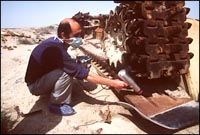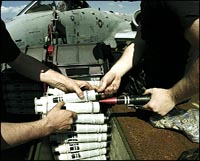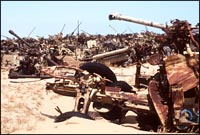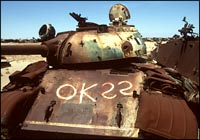THURSDAY, APRIL 29, 1999
A SPECIAL REPORT - THE TRAIL OF A BULLET
A rare visit to Iraq's radioactive battlefield
Scott Peterson, Christian Science MonitorKHARANJ, SOUTHERN IRAQ
The men who guard the ruins of the remote Kharanj oil-pumping station near Iraq's border with Saudi Arabia don't wander around much.Destroyed by US air raids during the 1991 Gulf War, parts of this facility remain "hot" - radioactive. So the guards confine themselves to one small building to avoid wreckage contaminated by US bullets made with depleted uranium (DU).
STILL 'HOT': Mahmoud Hossein, an official of Iraq's Atomic Energy Commission, checks an Iraqi tank hit by DU bullets near Basra,
southern Iraq, and finds it to be
radioactive. Some experts say the DU radiation is only mildly dangerous. Others counter that ingestion or inhalation of even a particle of DU carries high risks.
(SCOTT PETERSON)
The wind is a constant companion in this desert, but today it has eased. Driving into the former battlefield, as on a rare visit last year facilitated by Iraqi authorities at the request of The Christian Science Monitor, this reporter passes south through Iraq's rich Rumeila oil fields and along the area near Kuwait, which is pockmarked with rusting tanks and vehicles.These machines were targets of armor-piercing DU "penetrators," the bullet of choice for American tank gunners and pilots during the Gulf War. Pentagon figures show that at least 860,000 DU rounds were fired.
Along a side road, a group of falconers are hunting, unaware of the potential risks, while elsewhere two men search for mushrooms.
Radiation occurs almost everywhere in nature, at low levels known as "background." But DU is a concentrated form, nuclear scientists say. It is the "tailings" left over from the enrichment process that produces nuclear fuel and bombs. When a DU bullet burns on impact, it turns to particles that emit potentially dangerous radiation.
Here, where the guards gingerly carry out their duty at the Kharanj pumping station, clues of radiation are plentiful. The bullets are now spent. The depleted uranium was either turned into dust or broke into fragments that now corrode in the sand.
But among the clues is one DU round the size of a thick marker pen that was fired from the sky at a 45-degree angle and grazed a wall. It created an eight-inch-long skid mark of encrusted DU particles. Mahmoud Hossein from Iraq's Atomic Energy Commission handled a radiation detector in a visit to the site observed by the Monitor.
Swept over the black specks of DU dust near a bullet-entry hole in a protected doorway, the instrument erupts with staccato chirping. Its meter surges to 35 times background levels, causing Mr. Hossein to appear startled.
The fighting that took place on these battlefields seven years ago (see map, page 14) was so intense and released so many pulverized DU particles that the entire area was almost certainly drenched in radioactive and toxic grit.
In the midst of the Rumeila north oil field, Iraqi officials examine a destroyed armored vehicle mired in wet sand. The turret had been blown off and sits 50 yards away. It is radioactive, along with the toe of a military boot.
But, for some, the danger is easy to ignore or to miss altogether.
An Iraqi officer jumps into the rusting hulk, radiation meter in hand, even as DU particles inside makes the instrument sing.
A glance behind shows that this site often gets local visitors. On the moist sand, clearly defined, is the fresh imprint of a bare human foot.
The URL for this page is: http://www.csmonitor.com/durable/1999/04/29/fp13s1-csm.shtml
(c) Copyright 1999 The Christian Science Publishing Society.
http://www.csmonitor.com/durable/1999/04/29/fp1s2-csm.shtml
SPECIAL REPORT: Part 1
The armor-piercing wonders of depleted uranium helped win the Gulf War. As it is loaded for use in Kosovo, questions about its long-term dangers linger. First of two parts.
Scott Peterson
American anti-tank gunners in the Gulf War raved about it. It was their "silver bullet," piercing the armor of Iraq's Soviet-made tanks as if they were soda cans.Gunners became accustomed to first-round, tank-fired shots that ignited Iraqi T-72s with such force and fire that the result was dubbed "Dante's Inferno." Fired from A-10 "tank-buster" planes in 30-mm form, this bullet stopped armored convoys in their tracks.
This is the tale of a high-density bullet made of depleted uranium (DU), a low-level radioactive waste left over from the making of nuclear fuel and bombs. Because of its success, DU has already become a staple of the US military's arsenal. It has been sold by the US and Russia to other forces all over the world.
In the war over Kosovo today, NATO has loaded DU rounds into the guns of Air Force A-10s. So far, the Air Force says, this highly effective antitank ordnance has not yet been used.
Wherever it is fired, it leaves a radioactive trail. A Monitor investigation of the Persian Gulf war zone, where this bullet saw its first live action in 1991, found that it has left the desert sprinkled with radioactive and chemically toxic dust.
Clues in how DU is handled
How dangerous is this unseen residue once the battle is over - whether in Iraq's southern desert or in a Kosovo to which hundreds of thousands of refugees are meant to return?The US military has given mixed signals. A series of Pentagon reports and regulations cite serious health risks from depleted uranium, and still stipulate stringent, moon-suit type protective gear when approaching objects hit with DU bullets.
LOADED WITH CONTROVERSY: Airmen prepared 30-mm depleted-uranium rounds for an A-10 'Warthog' plane this month in Aviano, Italy, a base used for strikes on Yugoslavia.
(US AIR FORCE /AP)
And the Nuclear Regulatory Commission requires the military to have a license to make or test fire a single DU round. In part because of safety and environment concerns over DU, the US Navy opted to use tungsten for its armor-piercing bullets.But Pentagon officials today downplay that risk and cite other Pentagon reports that back their view. They confirm that thousands of US soldiers were "unnecessarily exposed" to DU in the Gulf, adding their view that those exposures were "not medically significant."
In Iraq, however, physicians describe a sharp upward spike after the Gulf War in the kind of health diagnoses - such as cancer - associated with exposure to radiation. Iraqi veterans interviewed by the Monitor supported those claims, if only anecdotally.
Perhaps one cause among many
But any increase in Iraqi health problems may have another cause, or many causes. The Gulf War was the scene of a "toxic soup" of dangerous chemicals. The Iraqis, and some American physicians and scientists, argue that DU is one of the most dangerous.Indeed, some Western scientists who have examined DU believe that it could be one of the factors behind Gulf War syndrome - the much-studied, little understood set of symptoms claimed by as many as 1 in 7 US Gulf War veterans.
The American military designed DU bullets in the 1970s, during the cold war, to counter Moscow's advanced T-72 tanks. Denser than lead, DU burns and self-sharpens when it hits a hard target and scorches its way through inch after inch of armor in, literally, a flash.
American forces - and, to a very small degree, their British allies - fired the 320 tons of DU that was shot across the deserts of Kuwait and southern Iraq, where most of it still lies.
But it does not lie quietly. A Monitor reporter who traveled throughout the region watched a radiation detector carried over parts of those battlefields register about 35 times normal background radiation. Portions of old tanks "killed" with DU bullets showed radiation levels 50 times above background - results similar to what US Army teams found during the war.
Risks as a breathable dust
When DU is protectively encased and carefully handled, its health risks are considered small. So if DU is outside the body, these are not especially dangerous levels of radiation.But when it smashes at Mach II into metal, DU burns and pulverizes into dust that can soar in the heat column of a flaming tank and waft for miles on the desert wind.
It is when this dust is inhaled or ingested that it becomes most dangerous as a radioactive substance and a toxic heavy metal, some experts say.
So far, DU bullets have received only limited public attention, though the Pentagon predicts that every future battlefield is likely to be strewn with their residue.
Reporting from Iraq, Kuwait, and the US, this Monitor series examines the possible long-term effects of this powerful spinoff of the nuclear age.
If there is a connection between human suffering and DU, then its use in the future will mean that lands of conflict will remain contaminated for the 4.5 billion years - a figure comparable to the age of the solar system - that DU remains radioactive.
PART 2 - THE TRAIL OF A BULLETPentagon stance on DU a moving target
Amid official attempts to nail down 'protection guidelines' for those confronting depleted uranium, Gulf War veterans press for clarity. And the prospect of DU's use in Kosovo raises the stakes.
Scott Peterson, Staff writer of The Christian Science Monitor
BURLINGTON TOWNSHIP, N.J.
A soldier's boots are often treated with sacred regard, once they carry a warrior safely through combat.But for one US soldier, who volunteered for his Gulf War tour, Mark Panzera, his boots were the first sign that something was very wrong.
He was an Army mechanic in the 144th Service and Supply Company of New Jersey, which in 1991 prepared US tanks and Bradley Fighting Vehicles that had been hit by "friendly fire" for shipment home.
This front-line equipment had been inadvertently hit by American gunners shooting radioactive depleted-uranium (DU) bullets at what they thought were Iraqi tanks.
For weeks after the mistake, the 144th worked at a salvage site in Saudi Arabia, getting into every corner of every vehicle to recycle equipment, wearing T-shirts and shorts, eating on and sleeping beside the vehicles.
Suddenly one morning, Mr. Panzera recalls, before his team began work, two experts arrived looking like astronauts, wearing hooded masks and suits - and carrying radiation detectors.
Before the two unexpected visitors approached the vehicles, they first ran their instruments over the awestruck mechanics. Their clothes were contaminated, but Panzera's boots especially set the detectors crackling.
REFUSE OF WAR: Destroyed Iraqi tanks, artillery, and armored vehicles rust at a collection point known as the 'boneyard' in the Kuwaiti desert. Many were struck by DU rounds and later brought here by unprotected workers. (SCOTT PETERSON /GAMMA-LIAISON)
The dust left over from the impact of DU bullets hitting the tanks had clung to the cleanup crew."'You're hot,' they told us, and I asked: 'What do you mean?' " Panzera remembers. "I was angry. Nobody tells you nothing, and the next day you are contaminated."
Later, Panzera received an official letter confirming his exposure to DU radiation. He has been seeking government compensation for what he says is DU-related illness.
Mixed messages from the top
By the Pentagon's own admission, its policy toward use of DU weapons has been inconsistent. Several military and independent reports describe the potential danger of DU particles trapped inside the body, though most deem the overall risk to be "acceptable." Strict federal and military rules govern every aspect of DU use and decontamination.But the Pentagon today calls its own regulations - based on US Nuclear Regulatory Commission (NRC) guidelines, which require masks and suits when dealing with DU contamination - "total overkill."
In 1993, a report from the US General Accounting Office, the government's investigative arm, found that Army officials "believe that DU protective means can be ignored during battle."
Then, in 1995, all four branches of the US military approved a multimedia DU training kit. In January 1998 it was endorsed as "impressive" by the deputy secretary of defense, John Hamre.
The kit, obtained by the Monitor through the Freedom of Information Act, said "the greatest threat is during open-air, live-fire testing. We can call combat a great big open-air, live-fire test." An area hit by DU "remains contaminated, and will not decontaminate itself."
The kit was never issued, and it is now under review.
"They [the NRC] have their own standards. The military's [standards] are under review," says Bernard Rostker, the Pentagon's special assistant for Gulf War illnesses. He first raised doubts publicly only last August. He said the "extremely restrictive" NRC rules are "poorly suited" to war, and "need to be rewritten."
Reasons for backing DU
Critics say the Pentagon has reasons for its apparent downgrading of DU dangers: The bullet pierces enemy armor like no other, it's cheap, and any confirmed link with health problems could trigger a flood of compensation and reparations claims.And the cost of cleaning up DU residue in the Gulf would be prohibitive, as well. The price tag for removing 152,000 pounds of DU in the now-closed, 500-acre Jefferson Proving Ground in Indiana has been estimated to be $4 billion to $5 billion. More than four times that amount of DU was spread during the Gulf War, over a significantly larger area.
"The government is institutionally incapable of telling the truth on this matter," says Bill Arkin, a former military intelligence analyst and columnist for The Bulletin of the Atomic Scientists. His analysis: DU is too troublesome for the Pentagon to keep in its arsenal.
In January 1998, Rostker reported that "failure" to alert troops to DU hazards "may have resulted in thousands of unnecessary exposures," but said those exposures "had not produced any medically detectable effects."
REFUSE OF WAR: Destroyed Iraqi tanks, artillery, and armored vehicles rust at a collection point known as the 'boneyard' in the Kuwaiti desert. Many were struck by DU rounds and later brought here by unprotected workers. (SCOTT PETERSON /GAMMA-LIAISON)
Angry veterans say that DU could be a reason that an estimated 1 in 7 of them report a set of symptoms known as Gulf War Syndrome, and have pushed their case on Capitol Hill. They estimate that hundreds of thousands of troops were exposed to DU during the fighting or on post-battle tours of the front line. Climbing on destroyed Iraqi tanks was a favorite activity, along with collecting war souvenirs. Among other sources, the veterans point to a 1990 report commissioned by the US Army that links DU to cancer and also makes clear that "there is no dose so low that the probability of effect is zero." They also remember Pentagon reluctance to divulge health hazards in the Vietnam War."This [DU] is the Agent Orange of the 1990s - absolutely," says Doug Rokke, a former Army health physicist who was part of the DU assessment team in the Gulf War, and DU project director for the training package.
Underscoring the official inconsistencies, Sen. Russell Feingold (D) of Wisconsin said in September that the Pentagon's "assertion that no Gulf War veterans could be ill from exposure to DU ... contradicts numerous pre- and postwar reports, some from the US Army itself."
As much politics as science
In a sign of the Pentagon's own confusion, Rostker told a White House oversight panel last November that he was "misguided" to issue so strong a statement - that ruled out DU as a cause of Gulf War Syndrome - in an August report. "I stand corrected," he stated.The problem seems as political as it is scientific: "Misinformation disseminated by both the Iraqi government and the US Department of Defense has made analysis of DU impacts difficult," notes Dan Fahey, Gulf War veteran and author of an extensive DU report for veterans' groups published last year.
KICKING UP A STORM: An American M1A1 battle tank, on maneuvers in Kuwait last year, shows the ease with which dust and particles can be resuspended in the desert air.
(SCOTT PETERSON /GAMMA-LIAISON)
Protection guidelines for handling DU are as difficult to establish as a single speed limit for every American road, says Ron Kathren, director of the US Transuranium and Uranium Registries in Richland, Wash. But NRC guidelines "are in fact adequate" for DU, he says, and "if they are 'overkill,' that's OK, too. I'd rather err on the side of safety."
Col. Eric Daxon, a senior Pentagon radiation expert with the Armed Forces Radiobiology Research Institute, said in an interview that the military needs to come up with its own "acceptable risks" of DU, compared to the other threats of combat.
Protecting soldiers from DU can also put them at risk during battle, he said. Gas masks and suits can overheat a soldier and impair vision. The goal today is to keep exposures "as low as reasonably achievable," he adds.
"Reducing the total risk ... of getting shot, of getting wounded, of getting long-term cancers" is the new aim, he says. "We are really trying to balance all of those things."
As the Pentagon now weighs the use of DU munitions in NATO's war against Yugoslavia, the debate about the risks of DU is certain to escalate.
"I think we have been inconsistent," says the Pentagon's Rostker in the interview. "We published a standard ... that is inconsistent with the hazards of DU."
Disillusioned
As those arguments continue, Panzera has had several operations and health problems that he attributes to his DU exposure. Worried about taking contamination home before he left the Gulf, Panzera cut holes in his uniform and exchanged it for a new one. He left his soldier's boots "in the middle of the desert.""I guess they are waiting until half of us are dead before they give in," he says, echoing the view of many US veterans whose patriotism has long since given way to cynicism. "My volunteering days are over."
The URL for this page is: http://www.csmonitor.com/durable/1999/04/30/fp8s1-csm.shtml
|
Races? Only one Human race United We Stand, Divided We Fall |
 |
No time to waste. Act now! Tomorrow it will be too late |
|






































